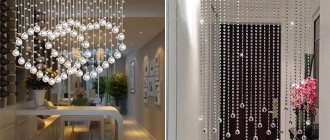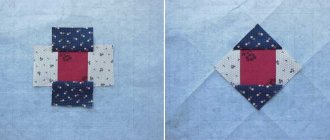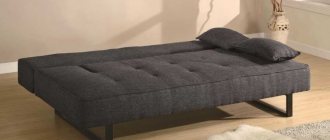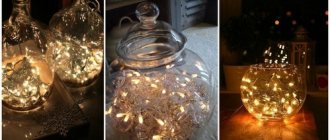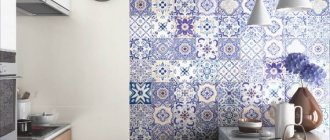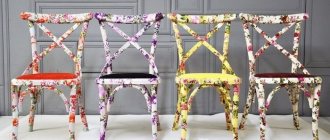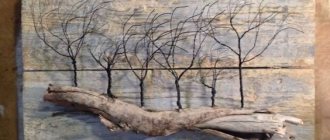It’s easy to get confused in the huge amount of information on how to weave a Macrame panel on a wall with your own hands. We will help you systematize this knowledge, teach you how to read Macrame weaving patterns and create a panel sketch yourself. We will introduce you to several master classes on making panels for beginners and not only, and also show examples of using Macrame in the interior.
Examples of Macrame panels on the wall
There are many examples of the use of wicker panels in interiors. Notice how beautiful and modern they look.
Panel with an antique twist
Pretentious and delicate baroque
Strict modern
Very often there are panels not only rectangular, square, but also round in shape.
Weaving panels in the Macrame style is one of the areas of textile weaving.
Panels can and should be not only aesthetic, but also functional. The prototype of ancient military banners is a panel with a pentagon-shaped pocket. This is the simplest option, but sometimes more complex products are found. This panel can be used to decorate the kitchen, and the pocket can be used to store spices and seasonings.
In the bedroom, an original decoration will be a panel on the wall near the bed, which will add zest to the interior of the room.
A very popular panel is still the beloved owl, as a symbol of wisdom and good luck.
What material is needed to weave panels using the Macrame technique? Everything that is used for weaving and other products using this technique, and this is:
- hemp, linen, paper ropes;
- flat braid;
- cotton threads.
The material is selected so that it is convenient for the master to work and the knots are clear and beautiful.
How macrame came into our lives
The technique of weaving, or more generally, tying knots, has been developed and improved over thousands of years. In primitive times, weaving knots was an essential skill, without which it was impossible to make a net or build a hut.
Two-color panel Source amazon.com
It is not surprising that the art of weaving arose independently wherever people lived. Gradually the techniques improved and became more complex. In the ancient states of America, in Ancient China and Babylon, even knotted writing appeared, in which information was transmitted by combinations of colors and knots.
It is believed that the basis of modern technology was laid by sailors of the Renaissance, accustomed to weaving complex knots on ship rigging. During breaks between shifts, they wove useful things for everyday life - belts, bags, hammocks. This helped pass the time and earn money on the shore.
Macrame curtains in different styles Source ivybush.ru
The word “macrame” itself entered the Russian language from French or English, but the root is of Arabic origin and means fringe or braid. Over the past century, interest in technology has had its ups and downs. Fifty years ago it was undeservedly forgotten, but at the beginning of the 21st century it began to be revived and turned into a fashionable type of needlework.
The art of macrame has gained admirers all over the world. It is used to make bags, belts and hats, and to decorate clothes; weave bedspreads and curtains. The possibilities of macrame are also useful in interior design.
Weaving a multilayer panel Source 7roomz.de
Panel weaving patterns
It’s worth mentioning right away that there are no patterns for weaving Macrame panels as such. The main thing in this product is the primary sketch. As a basis for it, you can take not only a painting, an image, but also a mosaic, an ornament, or simply a certain theme.
To create a sketch, a simple selection of a beautiful combination of weaving knots will do.
You can also use photographs of already created panels to navigate them and create your own.
A Christmas tree and a snowflake are the theme of New Year's macrame, and flowers are the theme of summer. In the fall, a herbarium of beautiful leaves will inspire creativity.
To make a sketch, you can learn to use graphic editors such as Photoshop, Corel Draw, GIMP. You can create a unique panel design on paper using imagination and simple Macrame knots.
Whatever pattern you choose, you must strictly observe the sequence of weaving and the accuracy of all Macrame knots. After all, a product made clearly and slowly will become a decoration of the home and the pride of the one who created it.
An example of one of the patterns applicable for weaving panels is a border of rhombuses made with grosgrain knots:
Macrame panels in the interior
In what interior styles will Macrame panels be relevant? Since this art came to us from the ancient East, the decor will be most harmonious in oriental interior styles.
It will look no less successful in a room decorated in Boho style.
Boho style panel
One more thing
In romantic interiors:
Tender romance
Brighter decor
And white and beige products will look great in the Scandinavian style.
Snow-white minimalism
Scandinavian eco-style
Peace and freedom
And perhaps, over time, Macrame will become a profitable business for you, because now panels using the Macrame technique are successfully sold at various fairs and online sites for selling hand-made goods.
Look how diverse and beautiful the world of Macrame is!
Weaving a simple macrame cradle with your own hands
To weave a rocking cradle for a newborn, you will need durable synthetic cords, which can be purchased at construction markets or in handicraft stores. Thinner threads may break under the weight of the child.
Master class on weaving a macrame cradle:
- Braid each of the base ovals with thread, placing the turns close to each other.
- Attach sixteen doubled cords to the larger oval at equal distances. The length of one cord should be 5-6 times the size of the finished product.
- Divide the cords into eight groups of 4 cords and tie a square knot from each of them, at a distance of 4-5 cm from the base.
- Weave a mesh of threads with jumpers of square knots. The distance between rows should be 5-6 cm.
- It is necessary that the length of the mesh matches the depth of the cradle.
- Now take the smaller oval and attach 16 threads to it. Weave them into a mesh with jumpers made of square knots. This network should form the bottom of the future cradle.
- Tie the bottom of the mesh of the top oval to the bottom one. Trim any excess cords.
- Tie two strong cords tightly on four sides. For them you will hang up the crib.
You can weave a simple macrame cradle with your own hands
The baby's cradle is ready. Now all you have to do is hang it on the spring you prepared earlier. If desired, you can make a pocket for a pacifier and rattles from a mesh woven using the macrame technique.
Macrame panel owl (step-by-step master class)
(Translation by Diana Silantieva)
Starting this work, you must learn how to perform the following Macrame knots:
- double flat knot
- fastening the thread with a knot at the front
- “chess” of double flat knots
- chain of their double flat knots
Material for work
- 10 m of regular cotton thread No. 10;
- two beads for eyes;
- two small wooden sticks;
- brush and wood-colored paint for painting;
- PVA glue;
- electrical tape for attaching the work to the work surface.
First stage. Attaching the thread
Cut the thread into 10 pieces of 1 m each. Attach with a knot on the front side of the work to a stick. Secure the ends of the stick to the work surface with electrical tape.
Second phase. Weaving the top of the head
We weave a “chessboard” of double flat knots on 8 middle threads, grabbing a pair of threads from the outermost knot of the previous row on each side.
Working with the first two strands, using them as a warp, make loop knots, alternately working each of the next 8 strands.
It is necessary that the “bulge” of the knot is on the front side of the product.
Repeat exactly the same on the right side of the owl. The nodes should be a mirror image of the left side.
Third stage. Beak weaving
The owl's beak is made on four central threads. We weave a chain of 4 flat knots. Next, you need to apply glue to the tips of the fourth threads on both sides. When the glue has dried, trim the ends of the threads at a slight angle. String one bead on each of these two strands.
Bend the chain of double flat knots so that it bends forward. Then make a berry knot. The beak is ready.
Fourth stage. Weaving the lower part of the head
To prevent the owl from sagging on the sides, be careful when weaving further.
We continue working from the center, using threads No. 9 and No. 10 (previously used for the beak) as warp threads, we make loop knots, alternately working with threads from the left. Make loop knots so that the “bulge” of the knots is located on the wrong side of the product. Do the same on the other side, only in a mirror image, using threads No. 11 and No. 12 as main threads.
It is important! Be sure to adjust the thread tension so that they do not sag. This will make the owl's head look neat.
Then we weave a “chessboard” of double flat knots, adding two threads on each side in each subsequent row. The owl's head is ready.
Fifth stage. We weave the wings of an owl
We form a chain of 6 double flat knots on the outermost 4 threads on the left. Do the same on the four outermost threads on the right.
Sixth stage. Execution of the torso
We weave a “checkerboard” of double flat knots on 12 medium threads. Repeat weaving 3 times (6 rows of chess in total).
Connect the owl's wings to the body by tying one row of double flat knots, grabbing pairs of threads from the two chains of knots that make up the wings. We weave another row of chess.
In the center of the owl’s body, using threads Nos. 7–10 and threads Nos. 11–14, we make two double flat knots.
Next, we make knots near the second stick, using threads Nos. 6, 5, 4, 3. Repeat the same action using threads Nos. 15, 16, 17, 18. These loop knots form claws, and the stick will serve as a pole.
Using all 20 strands, tie a row of double flat knots.
Seventh stage. Knitting an owl's tail
We weave the tail with a checkerboard pattern of double flat knots, grabbing one pair of threads on each side as we weave.
Eighth stage. Owl decoration
When you're done, steam the owl. Paint the sticks if desired, moving the owl to the side. Cut the threads parallel to the tail at an angle.
You can also weave large round eyes separately, paint them emerald and sew them to the main fabric. And instead of pupils you can use black buttons.
Svetlana Dvornikova shows the entire process of weaving the “Owl” panel in 2 parts:
How to make macrame correctly using weaving patterns
Introduction to macrame weaving patterns for beginners
You can weave not only panels and hammocks using the knot weaving technique. Craftswomen create earrings, necklaces, belts and lace to decorate clothing items.
First you need to decide on the quality of the threads for weaving and take into account several nuances:
- It is better for beginners to practice on cords of different colors;
- for work you need to choose threads with a round cross-section;
- synthetic threads are too slippery and difficult to fold into a beautiful knot;
- wool threads should be thick and well twisted;
- To prevent the threads from unraveling during work, you need to tie them at the ends into knots or melt them over a fire;
- weaving from rigid ropes will become easier if you wear thin knitted gloves;
- threads with noticeable pile are woven easier if you wet your palms with water from time to time.
To work, you will need a board or a book in landscape format. Some craftswomen attach threads to a special tube or rod of small diameter. But weaving knots in a canopy requires some preparation.
Preparation before work:
- Place the board in front of you with the wide side down.
- Make a loop out of the thread and wrap it around the board parallel to the floor (the knot should be on the reverse side). This thread will act as a bar on which you attach the working threads.
- Each knot has working and knotting threads. Knotted threads should be 5-7 times longer than working threads.
- Cut the required number of threads, fold them in half and fasten them as shown in the diagram.
Now you can weave the first training knots on this blank.
Macrame weaving knots and patterns for beginners
The square flat knot is the most popular element in the knot weaving technique. Macrame bracelets are woven using square knots.
A single flat knot consists of one loop. How to do this can be seen in the diagram.
A double flat knot is used for weaving floss baubles or other types of threads. Pay attention to the weaving sequence: each next knot should be a mirror image of the previous one. Otherwise, the resulting flat thread will begin to twist in a spiral.
From square knots you can weave a rhombus, as shown in the diagram.
The number of nodes is measured in tens. We will look at basic techniques with corresponding diagrams.
Knot chain.
Chameleon knot.
Tatting knot.
In the diagram you can consider and try other, no less beautiful techniques for creating knots.
Schemes for weaving panels on the wall using the macrame technique (with step-by-step photos)
A wall panel is a great opportunity not only to practice weaving techniques, but also an opportunity to create an original piece for your interior with your own hands.
For the panel you will need:
- 10 threads, 5 m each; scissors;
- wooden plank 45-50 cm long (it will become part of the future panel).
Operating procedure:
- fold each thread in half and secure it to the bar;
- distribute the threads so that the distance between them is the same (about 7-8 cm);
- from 1 and 2 threads weave a double flat knot in 3 passes;
- perform a similar operation with each subsequent pair of threads;
- separate 2 threads from the first knot (those that are closer to the center) and 2 threads from the second knot;
- weave a double flat knot from them in 3 passes and perform a similar operation with each subsequent pair of threads;
- repeat step No. 3 and secure the threads with knots located diagonally.
diversify your home decor and create original decorations with the help of “beaded flowers.”
How to weave a macrame belt (master class for beginners)
To work you will need:
- beautiful buckle with cross fastening for threads:
- silk or synthetic threads – 3 pcs. 10 m each;
- scissors.
Operating procedure:
- first you need to master weaving a double flat knot with a central thread (you can choose a different color for the central thread);
- attach the threads to the buckle as shown in the picture;
- weave until you get a belt of the desired length;
- to finish weaving, use the “diagonal bead roller” knot, as shown in the diagram;
Using this technique you can weave a watch strap.
Pattern for weaving macrame for flower pots (step by step for beginners)
DIY weaving patterns for macrame flower pots are varied and popular among craftswomen. Some people weave flowerpots from the top edge, others start weaving from the bottom. Let's look at simple schemes for beginners.
For work and training, you can use threads cut from old colored T-shirts . How to make such yarn can be seen in the photo.
Scheme for weaving flower pots from below:
To work you will need:
- 8 thread blanks, 2-3 m each (depending on the height at which you plan to hang the pot);
- a flower pot; scissors.
Operating procedure:
- Connect the ends of the blanks and tie one common knot. The resulting brush will be located at the bottom of the pot and will serve as an additional decoration.
- Separate the first and second threads and tie 1 flat knot at a distance of 5 cm from the main one.
- Connect all the other threads of the workpiece in pairs. As a result, you will have 4 nodes.
- Separate 2 strands from adjacent knots and tie them into a double flat knot.
- Repeat the operation with other threads so that adjacent nodes are connected in pairs.
- Repeat step 2 and check how securely the pot fits inside the finished planter.
Using the same pattern, you can weave a flowerpot, starting from the top. To do this, you will additionally need a ring for attaching threads. The lower part can be tied with a common knot and a second tier can be made for the second pot.
Here are some examples of interior design using simple flowerpots.
If you have a ready-made flowerpot, but no fresh flowers, you can make beaded trees with your own hands.
Stylish macrame jewelry
Knots can be used to create many practical and sophisticated things. Designer jewelry is highly valued, and the abundance of blanks for jewelry and decorative elements in handicraft stores will allow you to create original pendants and earrings. Original beaded bracelets will be a worthy addition to the set.
To begin with, you can practice on simple patterns and weave, for example, a keychain. For additional decoration you will need large beads, a key ring and multi-colored cords . How to do this can be seen in the diagram.
Handicraft stores are a separate universe, once in which it is no longer possible to leave without buying something. -Beaded brooches look exquisite and elegant, because no one else in the world will have these.
Pendants and necklaces can be made from any available materials. Lace, multi-colored threads and cords, multi-colored beads and openwork decorations are used. The operating procedure and diagram can be seen in the photo.

